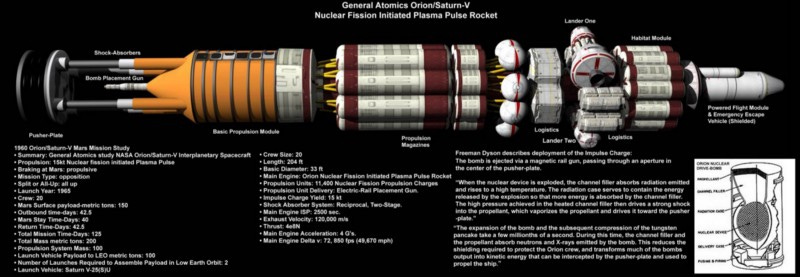It sounds insane and that’s because it is
Nukes aren’t particularly nice, they release a massive fallout and aren’t particularly great for people or the planet, but that didn’t stop scientists from thinking about what would happen if they used nukes to propel rockets through interstellar space.
Why would scientists ever in their right mind think of using nukes in a rocket? Because nukes are really, really powerful. It’s honestly not that different to an internal combustion engine, except rather than using exploding fuel to move a piston, you’re launching a nuke in space to move a spaceship. Nuclear propulsion offered high thrust with a high specific impulse (basically the efficiency of a propellant). To give an example of what this means, conventional chemical fuels, like those that power traditional rockets have a high thrust and low specific impulse, so they have a lot of force but don’t use their fuel very well. In contrast, electric thrusters like ion engines have a very, very small thrust but they use their fuel incredibly efficiently. Nukes combine the best of both worlds, so it’s obvious that you’d use them as rocket fuel.
Serious research into this came about in the 1950s and 60s, when governments around the world were trying to find more peaceful ways of using nukes that would benefit humanity rather than threaten to destroy it. It’s just that using nukes to propel a spaceship was one of the more ludicrous ideas that scientist had. Two of the key scientists who worked on the project were Freeman Dyson and Theodore Taylor, both of whom were instrumental in the plans to take humanity to space. They came up with the plan to effectively “push” the nukes out the back with metal disks. The explosion from the nuke would vaporise the these disks, creating plasma that would push the rocket upwards. It would take a lot more than one nuke though, in fact it would take around 800! However, this nuclear propulsion could accelerate the rocket to 2 or 3 times faster than conventional rockets could.
Unfortunately for the project, there were just some problems that could never be solved, the main one being radiation. It’s difficult to manage the radioactive fallout of just one nuke, so doing so for hundreds would be basically impossible. There was also the question as to what would happen if all the nukes detonated at once. Another big problem was the question of “how do you keep the astronauts alive?” The crew would be exposed to so much radiation that keeping them alive for long enough to get to orbit would be basically impossible. Finally, political and public support for nuclear technology was falling, and with the signing of the Nuclear Test Ban Treaty in 1963, Project Orion’s fate was basically sealed.
So would we ever see something like Project Orion again? Unlikely, but it’s possible. As humans start looking towards the moon and Mars, the issues of managing radiation will have to be addressed eventually, and if a solution is found, then one of the biggest challenges with Orion would be solved. If we can also build rockets in space, outside of our atmosphere, then we won’t have to worry about how the fallout would affect people on Earth. If somehow we could achieve all this, then the high speed and power of nuclear propulsion could help humanity explore further in the solar system like Saturn or even further. However, there’s still a long way to go before nuclear propulsion becomes something that isn’t completely crazy.
Sources:
https://interestingengineering.com/project-orion-the-atomic-starship-that-never-got-off-the-ground
http://www.astronautix.com/p/projectoriossiblerebirth.html
https://en.wikipedia.org/wiki/Project_Orion_(nuclear_propulsion)


